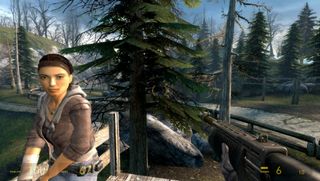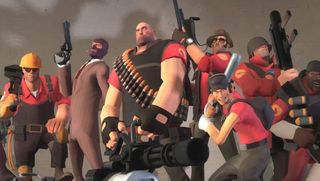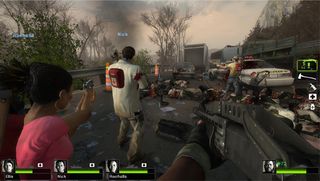Half-Life 2 creates quite a tease...

But even with its ventures into Steam and Source, Valve still hadnt forgotten about its roots. It just seemed like it did. But at E3 2003, the company finally revealed the follow-up to its beloved Half-Life. With the new Source engine and the anticipation of millions behind it, Half-Life 2 quickly became one of the most desired games of the year after Valve said itd launch in September 2003.
But then September came and went, and no game was released. Then Valves fans got upset. Then it continued to deal with an elongated legal battle with Vivendi Universal over VUs alleged copyright infringement (which Valve would later win). Then Newell revealed the company had been hacked, and that pieces of Half-Life 2s levels and code had been leaked on the internet. Then the fans got worried. Then the game got delayed until later in 2004. Then people got angry.
...but proves to be worth the wait

But in November 2004, Valve stuck to its word and finally released the long-awaited sequel to the public. Half-Life 2 immediately achieved, and arguably surpassed, the success of the original, wowing audiences and critics alike with its looks, atmosphere, and inventive combat. A vocal minority of players were peeved about being forced to run Steam in order to play the game, and Steam itself had some crashes with millions of players trying to authenticate their copies at once. But those concerns would eventually die down. Half-Life 2 has sold more than 10 million copies and won innumerable awards and commendations since.
When the dust was settled on the big launch, the same post-launch flurry of mods and expansions that followed Half-Life 1 arrived again. The most successful of those is a simply-named sandbox tool called Garrys Mod, which has since made more than $22 million in sales and has been behind a large number of machinima-style videos. Various other Half-Life 2 mods continue to be built and released by the community today.
Valve sets up a big package...

By 2007, Valve was making moves. The stream of Half-Life 2 content continued to flow; Steam continued to expand and improve; and Source had established its place in the community. Two years earlier, Newell and company hired a young group of graduates from Washingtons DigiPen Institute of Technology after taking interest in a small puzzle game they developed called Narbacular Drop.
In 2006, Valve launched the first in a planned trilogy of narrative-based Half-Life 2 expansions: Half-Life 2: Episode One. And while all of that was happening, the company continued to plug away on that old Team Fortress follow-up it had promised seven years earlier.
...and delivers it in an Orange Box

All of this came to a head with the October 2007 release of The Orange Box, which to this day is considered one of the best bargains in gaming history. For the price of one game, you got five: Half-Life 2, Half-Life 2: Episode One, the new Half-Life 2: Episode Two, the hotly-anticipated multiplayer shooter Team Fortress 2, and the spiritual successor to Narbacular Drop, Portal. The whole package launched on Xbox 360 and PlayStation 3 (though the latter version was handled by EA and horribly ridden with bugs) along with Steam, which helped bring Valves catalogue to an even wider audience than before.
Every game in the collection was well-received, but particular praise went to Portal. It was a master class of game design and something legitimately unique in an homogenizing market; and many people (ahem, ahem) now consider it to be one of the greatest accomplishments of the medium. Team Fortress 2s new cartoony look was derided by some fans after it was first revealed at E3 2006, but its developed a large, dedicated and hat-loving player base that only expanded when it went free-to-play in 2011. And Half-Life 2: Episode Two ended on a thrilling cliffhanger, setting up a highly desired conclusion to the trilogy.
Left 4 Dead shoots and shambles its way to success...

In 2006, a California-based developer named Turtle Rock Studios announced that it would use the Source engine to create a new zombie-themed survival game called Left 4 Dead. Valve, as it had done numerous times in the past, soon took an interest in the project, and in January 2008 it acquired Turtle Rock with the explicit purpose of finishing and releasing the title. And once again, it proved that it had good taste when it came to picking out potential projects.
Left 4 Dead formally launched on Steam and Xbox 360 in November of that same year, and when it arrived it was a campy zombie FPS with a particular focus on co-op play. It only had four levels to start, but they were each dictated by an adaptive AI that changed item spawns, music cues and zombie types each time you played. It didnt have much of a written narrative beyond survive and shoot zombies, but the gameplay could legitimately be called dynamic, and its co-op bent made it a hoot to play with friends. Like Portal, Left 4 Dead felt like something fresh. It sold well, and it achieved widespread acclaim.
...but Left 4 Dead 2 starts off shaky

So with that being said, youd think Left 4 Deads fans would be pumped to hear that a sequel was coming just a year later, right? Wrong. Indeed, Valve surprised the community by revealing Left 4 Dead 2 at E3 2009 and pegging it to arrive in November of that year. And indeed, some fans werent very happy. The backlash stemmed from Valves earlier promise to continue supporting the original Left 4 Dead with DLC and expansions after it launched. With a brand new title coming so soon, they thought, the first game would be abandoned, and theyd have to plop down another $60 to get all the new content.
Close to 40,000 fans even started a boycott of the game in protest (in a Steam community group, no less), but as usual with these kind of squabbles, things died down soon enough. Valve would go on to release a couple of DLC packs for the original game, and when Left 4 Dead 2 launched in November, most players had no problem paying for what was an improved, deeper version of an already fun title. Left 4 Dead 2 received expansions of its own in 2010, and it could safely be considered another all-around success.
Expected and unexpected sequels leave their mark...

Valve continued to supervise the releases of multiple new games after Left 4 Dead 2 launched. In 2010, it was behind the free, top-down multiplayer shooter Alien Swarm. In 2011, it launched Portal 2, which fleshed out the original into a longer adventure and added a co-op mode. It earned high praise once again, and was notable for bringing special Steamworks support to its PlayStation 3 version--a surprising move since Newell had called the PS3 a total disaster four years earlier. In 2012, it helped launch a modernized Counter-Strike dubbed Counter-Strike: Global Offensive.
Also in 2011, Valve launched the beta version of Dota 2, its first multiplayer online battle arena (MOBA) game and the unofficial follow-up to a popular Warcraft III mod called Defense of the Ancients. Two years prior, Valve hired IceFrog, one of leading guys behind that original mod, and set him to work on creating kind-of-but-not-technically sequel to the project (hence why its called Dota, not DotA, like the original). These blurred lines resulted in a lawsuit from Warcraft dev Blizzard, but the two sides settled in mid-2012, and Dota 2 formally launched this past July. It, too, was received well, and its earned itself a rabid, dedicated community of players.
...but theres one(+2=HL3!!!) game were all waiting for

Which brings us to the present, where past several months for Valve have been dominated by two questions. The first is simple enough: Whose headcrab do we have to smash to get Half-Life 3/Half-Life: Episode Three? Now, the fact that theres been a delay shouldnt come as a surprise; after the sagas of Half-Life 2 and Team Fortress 2, Valves rightfully earned a reputation for teasing its fanbase with protracted development times.
But given that its been six years since Episode Two launched, and given that Valves kept almost completely quiet about any future Half-Life games since, this particular wait has seemed especially brutal for diehard fans. The most recent glimmer of hope came earlier this week, when a European trademark for a Half-Life 3 was leaked and confirmed to be from Valve. But officially speaking, we still cant say when well be able to write Half-Life 3 confirmed for real.
The play for the living room begins

The other major question thats been thrown around is a little less hazy: Is Valve making its own console? Rumors about a potential Steam Box swirled for months, and they were only intensified when Valve launched a living room-friendly Big Picture mode for Steam last year.
Thankfully, though, Valve clarified a great deal of the speculation recently. Now we know that there will not only be a Steam console, therell be many of them from multiple manufacturers. We dont know what they look like yet, but we know theyll come with a variety of price points and spec sheets, and we know theyll launch in 2014. We also know theyll run SteamOS, which is Valves brand new Linux-based operating system thats built around Steam itself. And finally, we know that these consoles will be compatible with Valves own Steam Controller, whose dual touchpad design is certainly different than typical gamepads. Select Steam members will get their hands on this new tech by the end of the year. We cant say how big of an impact this army of Steam Machines will have on console gaming, but one things for sure: After seventeen years of growth, Valve is still looking to expand.
The valves keep turning

So why do gamers love Valve so much? Well, probably because theyve been a winner. They drive you nuts with launch delays, yes, but almost all of their games have become instant classics. Steams DRM policies can be annoying, sure, but almost everything else about it is user-friendly. And Gabe Newells pinky might be worth more than your life, but whatever, hes, well, yeah, thats a lot of money.
And if youd like to get even steamier, be sure to check out our take on the Top 7 times everyone hated Valve and our personal Confessions of Steam summer sale addict.
